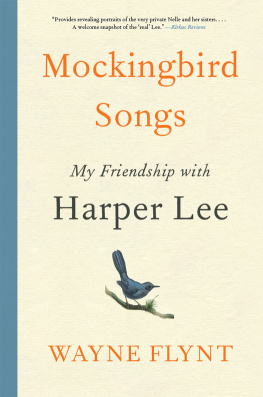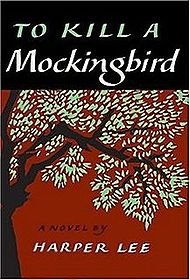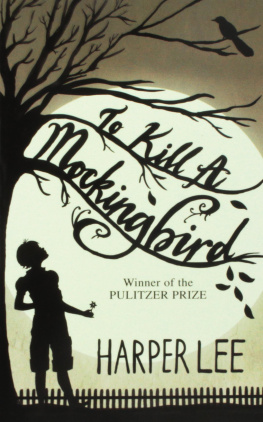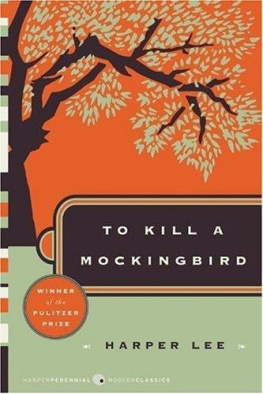Contents
Guide
To Alice, Louise, Nelle, and Dartie
Authentic Alabama Steel Magnolias
The song changes by singing
into a different song.
It sings by falling. The water
descending in its old groove
wears it new. The words descending
to the page render the possible
into the actual, by wear,
for better or worse, renew
the weary mind.
WENDELL BERRY, The Book of Camp Branch,
from Leavings: Poems

On a crisp spring day in 1993 not long after I received Nelle Harper Lees first letter, I was tending my rose garden when a male northern mockingbird began singing. Looking in its direction, I spied a calico cat halfway up a scrawny ten-foot-tall pine tree; up in the branches could be seen a small nest and chicks. The mockingbird, perched on the limb of an adjacent sweetgum, was singing fair warning of its intent to defend its family. The cat seemed frozen in space, torn between the nearby threat and the tasty morsels nearly within its grasp. Suddenly the bird dived for the head of the cat, which met the threat with an outstretched paw. The bird circled back to its perch and repeated the chorus of threats. When the cat resumed its climb, the bird swooped down again, this time attacking the cats haunches. Now completely absorbed by the standoff, I put down my tools and watched.
After minutes of parry and thrust, advance and stalemate, the cat realized that the prize, however close, was not worth the risk to its life. But when the poor animal decided to reverse direction, it lost its footing. Frantically trying to regain traction, the cat part ran, part fell to the ground, an avalanche of bark bouncing off its head and back. The mockingbird, merciless, continued its attack as the cat tried to restore its breath and balance. When sufficiently recovered, the cat raced across my yard in search of sanctuary. The triumphant bird, apparently taking me for the cats accomplice, swooped down at my head as I retreated into the carport. The mini drama concluded, the mockingbird returned to its perch in the sweetgum tree and resumed its singing.
Originally, the mockingbirds range extended toward Canada on both coasts of North America, but from the late 1800s to the early twentieth century the beauty and diversity of the birds songs attracted not only mates but also trappers. So many were captured to be sold as pets that they became scarce at the upper edge of their range. After the so-called cage bird trade ended, the species recovered and pushed its boundaries north again. Although ornithologists inadequately understand mockingbird migration patterns, they have established that some birds move south in the fall, while others prefer the northern edges of their occupation zone.
Why Harper Lee named her masterpiece after these fascinating birds may be explained in one of its key passages. After Atticus Finch tells his daughter, Its a sin to kill a mockingbird, Miss Maudie explains why: They dont eat up peoples gardens, they dont nest in corncribs, they dont do one thing but sing their hearts out for us. Thats why its a sin to kill a mockingbird.
Nelle Harper Lee was in many ways like the mockingbirds Miss Maudie described that hot Maycomb day. They are complicated and independentand so was she. They boldly defend themselves and their families from predators, including the two-legged variety, and so did she. And like Nelle, mockingbirds have the most piercingly beautiful song. For that reason, she spent much of her life eluding people who wanted to capture and cage her. I loved and respected her for her fierceness and her commitment to singing the songs she wanted to sing the way she wanted to sing them.
How does one chronicle a friendship? How does one remember the twists and turns, accidental meetings, serendipitous events, shared interests, and habits of the heart? How does a relationship progress from Dear Mr. Flynt / Dear Ms. Lee to Dear Wayne / Dear Nelle to Beloved Professor / Dear Madam Famous Author to Dear Ones / Dear Prime Suspect? How does mutual respect morph into formal acquaintance, warm friendship, and finally love?
These letters record the progress of my relationship with Nelle Harper Lee, but they can only hint at the reasons we became such special friends and correspondents, from the first letter between us, in 1992when she was sixty-six and I was fifty-twoto the last, about a year before she died in 2016. Perhaps in another life Nelle wanted to be a historian of the South, as I have been throughout my career as a writer and professor. Or perhaps, as Nelle sometimes hinted humorously, she fell under the spell of my wife, Dartie (whose name confused Nelle for years as she tried to master my pronunciation), who brought her exotic chocolate concoctions and told her so many funny stories, and I was merely the appendage who came with the deal. Perhaps we became close because Dartie and I were there for her at three critical junctures of her life: when her sister, Louise, slipped into dementia; when she herself suffered a stroke and, obsessed with maintaining her privacy, isolated herself at a rehabilitation facility; and when she was forced to give up her second home in New York City and live out the rest of her days in Monroeville, the town from which she had fled to freedom sixty-five years earlier. Or perhaps we three met in the twilight of our lives and just needed each other.
Although Nelle and I communicated for more than twenty years, we never worked together, lived in the same town, or talked for hours on the telephone. Our friendship hinged on certain encounters, most of them face-to-face, and in between was lots of time and spaceand letters. Her first to me was typewritten and formal. I didnt keep a copy of my response, but I remember that I replied in kind. She didnt write me again for a decade, not until a family crisis prompted her to reach out. From that point on, we both dropped our awkward formality in favor of ink-on-paper intimacy. Nelle preferred fine stationery. E-mail was never an option. Her letters were like those of two other southern literary icons of the time, Flannery OConnor and Eudora Welty. Sally Fitzgerald, editor of OConnors correspondence, notes that the Georgia master of the short story had a reputation for reclusiveness by inclination. But OConnor, like Nelle, was also a witty and gregarious storyteller and conversationalist who often penned wonderful letters.
Though she lived into the age of personal computers, Facebook, and Twitter, Nelle rejected them, vociferously and profanely, believing them merely alternative ways of invading peoples privacy.
Conversely, she once sent us a Charles Rennie Mackintosh card from her precious and dwindling stock purchased at the Hunterian Art Gallery at the University of Glasgow just because she wanted us to have one. Her letters are self-consciously of another age, less flirtatious, gossipy, and trivial than Jane Austens, her literary idol, and more like OConnors and Weltys: colloquial, chatty, funny, satirical, brutally honest, unflinching, emotionally warm, intensely personal. Because her circle of close friends was small, her correspondence was doubly treasured. In time, others will no doubt share their hoard of letters to, from, and about Harper Lee, and an editor will compile them, as R. W. Chapman did for Jane Austen and Sally Fitzgerald did for Flannery OConnor. This collection is, by comparison, small and far from comprehensive, but I hope it offers some interesting moments and important feelings in the life of my friend, and whets the readers appetite for more.
As for the hinges to our relationship, these are easier to identify. We first met LouiseNelle called her WeezieConner, and her little sister, Doty (a nickname of endearment for Nelle within the family), in March 1983 in Eufaula, Alabama. Louisewhose name Nelle would incorporate in her central character in
Next page







